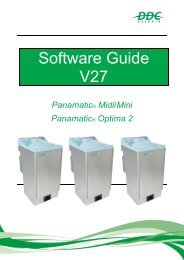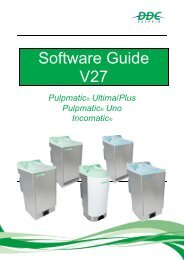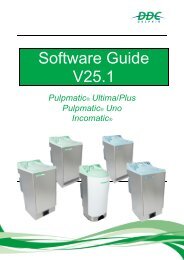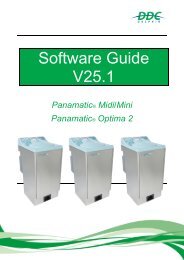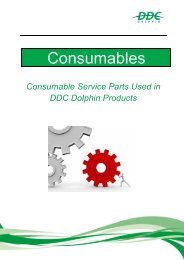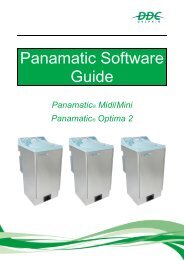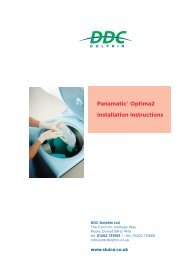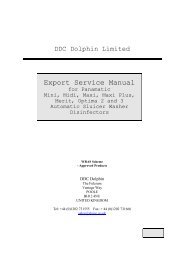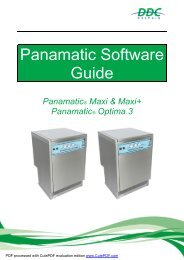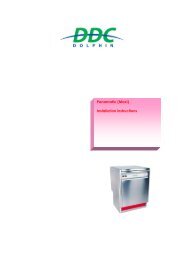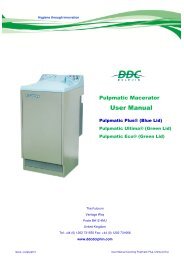Installation Guide UNO UL 110v V1.1
You also want an ePaper? Increase the reach of your titles
YUMPU automatically turns print PDFs into web optimized ePapers that Google loves.
<strong>Installation</strong> <strong>Guide</strong><br />
Pulpmatic® Uno Macerator<br />
<strong>UL</strong> Version<br />
H
1. Table of Contents<br />
1. Table of Contents ........................................................................................................ 2<br />
2. Copyright and disclaimer ............................................................................................ 4<br />
2.1 Copyright © 2015 ............................................................................................................... 4<br />
2.2 Disclaimer .......................................................................................................................... 4<br />
3. Application .................................................................................................................. 5<br />
3.1 Machine serial number ....................................................................................................... 5<br />
4. Delivery of the machine .............................................................................................. 7<br />
5. Cautionary notes ......................................................................................................... 8<br />
5.1 Safe operation .................................................................................................................... 9<br />
6. <strong>Installation</strong> process ................................................................................................... 10<br />
6.1 Plan the installation .......................................................................................................... 10<br />
6.2 Manual handling ............................................................................................................... 13<br />
6.3 Unpacking the machine .................................................................................................... 13<br />
6.4 Removal and fitting of foot cup assembly ......................................................................... 14<br />
6.5 Remove materials from chamber ..................................................................................... 16<br />
6.6 Remove the protective film ............................................................................................... 16<br />
6.7 Check internal parts ......................................................................................................... 16<br />
6.8 Cold water connection ...................................................................................................... 16<br />
6.9 Waste outlet connection ................................................................................................... 19<br />
6.10 Overflow connection ......................................................................................................... 22<br />
6.11 Electrical connections (must be compliant with IEC 60364) .............................................. 24<br />
6.12 Fix the machine to the floor .............................................................................................. 26<br />
6.13 Assemble the chemical system ........................................................................................ 28<br />
6.14 Boxing in .......................................................................................................................... 29<br />
6.15 Clean all outside surfaces ................................................................................................ 29<br />
6.16 Clear working area ........................................................................................................... 29<br />
6.17 Clean any scuff or marks on the floors or walls ................................................................ 29<br />
6.18 Fix the wall posters .......................................................................................................... 29<br />
6.19 Cover and protect machine until ready to use .................................................................. 29<br />
7. Request DDC Dolphin Ltd agent to commission the machine .................................. 30<br />
8. Scale management ................................................................................................... 31<br />
8.1 DDC Dolphin Scalematic Cartridge .................................................................................. 32<br />
Copyright © 2015 DDC Dolphin Ltd Page 2 of 36 November 15 IG<strong>UL</strong>-<strong>UNO</strong>-<strong>V1.1</strong>
9. <strong>Installation</strong> materials ................................................................................................. 33<br />
9.1 Optional installation kit ..................................................................................................... 33<br />
10. Summary requirements ............................................................................................. 34<br />
10.1 Specifications single phase <strong>110v</strong> ..................................................................................... 35<br />
11. Contact Details.......................................................................................................... 36<br />
Copyright © 2015 DDC Dolphin Ltd Page 3 of 36 November 15 IG<strong>UL</strong>-<strong>UNO</strong>-<strong>V1.1</strong>
2. Copyright and disclaimer<br />
2.1 Copyright © 2015<br />
The Copyright in this content is vested in DDC Dolphin Ltd and the document is issued in<br />
confidence for the purpose only for which it is supplied.<br />
It must not be reproduced in whole or in part or used for tendering or manufacturing purposes<br />
except under an agreement or with the consent in writing of DDC Dolphin Ltd. and then only on<br />
the condition this notice is included in any such reproduction.<br />
2.2 Disclaimer<br />
DDC Dolphin Ltd has a policy of continuous improvement across the range of products and the<br />
services we provide. We reserve the right to change specifications without prior notice. Illustrations<br />
are for guidance purposes only.<br />
We reserve the right to discontinue or change product specifications or designs at any time without<br />
notice and without incurring obligations. You should always contact DDC Dolphin Ltd for the most<br />
up-to-date information on our products.<br />
To the extent permitted by law, we are not liable for any errors, omissions or misrepresentations in<br />
any information provided in this document, or for any loss or damage suffered by persons who use<br />
or rely on such information.<br />
Copyright © 2015 DDC Dolphin Ltd Page 4 of 36 November 15 IG<strong>UL</strong>-<strong>UNO</strong>-<strong>V1.1</strong>
3. Application<br />
This manual should be used in conjunction with the other technical literature published on the DDC<br />
Dolphin Ltd online SharePoint portal. Other technical literature for this product includes:<br />
Level<br />
Educational <strong>Guide</strong>s<br />
1 User <strong>Guide</strong><br />
2 Site Engineer <strong>Guide</strong><br />
3 Technical <strong>Guide</strong><br />
4 <strong>Installation</strong> <strong>Guide</strong><br />
5 Commissioning <strong>Guide</strong><br />
6 Service <strong>Guide</strong><br />
7 Fault Finding <strong>Guide</strong><br />
8 Software <strong>Guide</strong><br />
9 Schematics<br />
10 Technical Updates<br />
3.1 Machine serial number<br />
The serial number assigned to the machine identifies the age and build date of the unit.<br />
15 05 110<br />
Year Month Consecutive<br />
machine number of<br />
assembled units<br />
during specified<br />
month<br />
Copyright © 2015 DDC Dolphin Ltd Page 5 of 36 November 15 IG<strong>UL</strong>-<strong>UNO</strong>-<strong>V1.1</strong>
DDC Dolphin Ltd has a policy of continuous improvement across the range of products we provide.<br />
Technical details, material and physical process may be different across the product range, please<br />
ensure you have the correct manual for the products you are working on. This manual is applicable<br />
to the following machines:<br />
Machine version Machine model no. Built from Built to<br />
EXPORT<br />
<strong>UNO</strong>0000-110V-<strong>UL</strong>2 Pulpmatic Uno (<strong>UL</strong>) 01/04/2015 Current<br />
<strong>UNO</strong>0000-110V-<strong>UL</strong>-A Pulpmatic <strong>UNO</strong> <strong>110v</strong> 60hz <strong>UL</strong> 16/12/2014 Current<br />
<strong>UNO</strong>0000-110V-<strong>UL</strong>-B Pulpmatic <strong>UNO</strong> <strong>110v</strong> 60hz <strong>UL</strong> 15/09/2014 Current<br />
PPM-CANADA-SAMPLE-A Pulpmatic <strong>UNO</strong> Canada Sample 10/06/2015 Current<br />
Copyright © 2015 DDC Dolphin Ltd Page 6 of 36 November 15 IG<strong>UL</strong>-<strong>UNO</strong>-<strong>V1.1</strong>
4. Delivery of the machine<br />
As the machine is delivered to site check the packaging for signs of damage. Remove the outer<br />
packaging and check the machine is free from damage. If damaged is detected, the machine<br />
should not be accepted from the delivery agent. Investigate the extent of the damage and how it<br />
may have occurred, take photos of the damage and call your supplier immediately. Damage<br />
detected after the machine is accepted from the delivery agent will become the responsibility of the<br />
client/site.<br />
Do not dispose of the packaging; this should be used to protect the machine until it is time to install<br />
the product<br />
Do not dispose of the packaging; this should be used to protect the machine until it is time<br />
to install the product<br />
Cut straps here<br />
Cut straps here<br />
Lift off carton<br />
Lift off carton<br />
Copyright © 2015 DDC Dolphin Ltd Page 7 of 36 November 15 IG<strong>UL</strong>-<strong>UNO</strong>-<strong>V1.1</strong>
5. Cautionary notes<br />
Failure to read and comply with the instructions in this manual may result in the<br />
incorrect installation and damage the machine<br />
! Do not override any of the safety features of this machine, doing so may damage the<br />
machine and endanger users of the machine<br />
! Remove installation parts from the cutting chamber before attempting to install the machine<br />
! Do not start this machine until it has been commissioned by a trained DDC Dolphin Ltd<br />
agent. This will damage the machine and invalidate the warranty<br />
! Do not leave the machine powered up until it has been commissioned as this will damage<br />
vital parts within the machine<br />
! Always use protective clothing when handling associated chemicals<br />
! Ensure the machine surfaces are covered and protected from abrasive dust and debris until<br />
the machine is ready to use<br />
! Do not stand or rest tools on the lid, this will scratch the surface<br />
! Do not manually force the lid up or down, this may damage the machine<br />
Risk of electrical shock, always isolate the electrical supply before working on the<br />
machine<br />
Risk of electrical shock, always isolate the electrical supply before opening the front panel<br />
All DDC Dolphin Ltd machines MUST be protected by a dedicated 30mA RCD/GFCI with<br />
over current circuit breaker. Circuit breakers must be trip type-c. All devices must be<br />
compliant with EN 60898-1/IEC 60898-1<br />
Copyright © 2015 DDC Dolphin Ltd Page 8 of 36 November 15 IG<strong>UL</strong>-<strong>UNO</strong>-<strong>V1.1</strong>
Nuisance trip of electrical circuit breakers may occur if more than one machine is<br />
connected to the same RCD/GFCI. If you experience nuisance trips please check the<br />
machine has a dedicated breaker and an individual RCD/GFCI for the machine.<br />
Water & electrical isolation switches MUST be installed within 1meter of the machine and<br />
accessible to the operator<br />
Electrical connections must comply with local regulatory guidelines<br />
All DDC Dolphin machines must be earthed (connected to ground)<br />
5.1 Safe operation<br />
• This machine should only be used for the purpose for which it was designed<br />
• Only maceratable friendly products should be put into the chamber<br />
• DO NOT place plastic or metal objects in the chamber<br />
• Always follow instructions detailed in the user manual<br />
WARNING<br />
If there is no active water connection, Turn OFF the electrical supply to prevent premature<br />
wear of the water inlet valve<br />
FLOOD WARNING<br />
This machine must be connected to a functional drain. The overflow connection is<br />
essential to prevent flooding in the event of incorrect operation<br />
Copyright © 2015 DDC Dolphin Ltd Page 9 of 36 November 15 IG<strong>UL</strong>-<strong>UNO</strong>-<strong>V1.1</strong>
6. <strong>Installation</strong> process<br />
6.1 Plan the installation<br />
Confirm with the client an exact location for machine prior to any works; explain the installation<br />
process and what is involved. Discuss and agree a safe working practice for the installation of the<br />
machine and the transportation of the machine if it is not in the desired location.<br />
Services<br />
Review the drainage requirements of the machine and inspect the services available, ensure they<br />
are suitable for product to be installed. Machine requirements are detailed in this manual. Ensure<br />
that the electrical and water isolators are easily accessible when the machine is fitted.<br />
The macerator should always be connected at the lowest section of the soil pipe in a room. All<br />
other devices such as a sink, hopper or bedpan washer should be placed uphill (on the soil pipe)<br />
from the macerator. This best practice will ensure any device emptying water and fluids into the<br />
soil pipe is flushing past the macerator and helping to wash the slurry through the pipe network.<br />
Location for the machine<br />
Determine how the client would like the machine to be fixed to the floor. This device must be fixed<br />
in place using expanding floor bolts (not supplied) or flexible adhesive (not supplied), If floor bolts<br />
are used ensure the area does not have under-floor heating, cables, pipes, etc.<br />
Ensure the floor covering if free from damage and in good order.<br />
Ensure the floor surface is flat and even, the macerator must be level. If the machine is not level<br />
this will cause uneven wear and strain on the motor, seals and cutting mechanism, in time this will<br />
impact the performance of the machine.<br />
Access to the machine<br />
Ensure the position of the machine allows users easy access to operate the footswitch, load the<br />
chamber and operate the start switch. Ensure there is sufficient room to work on the machine when<br />
conducting maintenance tasks.<br />
Clearance for the lid<br />
Ensure there are no wall mounted objects, cupboards, drying racks etc. which may impede the lid<br />
from fully opening.<br />
Copyright © 2015 DDC Dolphin Ltd Page 10 of 36 November 15 IG<strong>UL</strong>-<strong>UNO</strong>-<strong>V1.1</strong>
23 5/8” (600mm) 19 11/16” (500mm)<br />
59 1/16” (1500mm)<br />
37 13/16” (960mm)<br />
30 3/16” (766mm)<br />
8 11/16” (220mm)<br />
3 1/4” ( 83mm)<br />
Height of soil pipe must be 8 11/16” (200mm) from midpoint to floor level<br />
57” (1448mm)<br />
32” (813mm)<br />
55” (1397mm)<br />
36” (914mm)<br />
24” (600mm)<br />
Height of soil pipe must be 8 11/16” (200mm) from midpoint to floor level<br />
Copyright © 2015 DDC Dolphin Ltd Page 11 of 36 November 15 IG<strong>UL</strong>-<strong>UNO</strong>-<strong>V1.1</strong>
Height of soil pipe must be 8 11/16” (200mm) from midpoint to floor level<br />
Copyright © 2015 DDC Dolphin Ltd Page 12 of 36 November 15 IG<strong>UL</strong>-<strong>UNO</strong>-<strong>V1.1</strong>
6.2 Manual handling<br />
Use safe working procedures when moving or handling the machine. Use appropriate appliances<br />
to lift and move the machine. Handle the machine with care, avoid scuffs, scratches and damage<br />
during the installation process. Wherever possible keep the machine inside the packaging to<br />
protect the surfaces.<br />
6.3 Unpacking the machine<br />
Inspect the packaging of the machine check that it is free from damage, remove the packaging and<br />
check the machine is free from damage. These checks should be done when the machine is<br />
delivered to site. Retain the plastic machine cover; this can be used to protect the machine from<br />
dust and debris, if required. Dispose of any unwanted packaging in a safe manner and in<br />
agreement with the site/client.<br />
Un-bolt machine from pallet<br />
• Remove the outer packaging from the machine along with the clear plastic bag<br />
• Remove the front panel of the machine by removing the fasteners identified<br />
• Gently pull the front panel forward and down to remove<br />
• Store front panel & fixings in a safe place<br />
• Remove the foot switch plate (two nuts at rear of plate), see 6.4<br />
• Remove the two securing bolts, holding the machine to the pallet, with a 13mm wrench<br />
• Re-fit the foot switch plate & tighten the nuts<br />
• Re-fit the PCB housing and tighten the bolts<br />
• Lift the machine clear of the pallet<br />
Remove the two bolts, gently pull the front<br />
cover forward and down.<br />
Copyright © 2015 DDC Dolphin Ltd Page 13 of 36 November 15 IG<strong>UL</strong>-<strong>UNO</strong>-<strong>V1.1</strong>
6.4 Removal and fitting of foot cup assembly<br />
The foot cup assembly can be removed to gain better access to components on the base panel of<br />
the machine.<br />
Removal<br />
• Turn off the electrical supply to the machine and remove the front panel.<br />
• Locate and remove the two hex head bolts which secure the foot cup assembly in place<br />
and keep the bolts in a safe place.<br />
Hex head bolt located left hand side of<br />
machine<br />
Hex head bolt located right hand side of<br />
machine<br />
Lift front plinth assembly up to remove. Be<br />
careful not to stretch the foot cup wiring<br />
loom<br />
Note that the wiring loom to the foot sensor PCB will be still attached at this point and is<br />
on a short wire loom<br />
Copyright © 2015 DDC Dolphin Ltd Page 14 of 36 November 15 IG<strong>UL</strong>-<strong>UNO</strong>-<strong>V1.1</strong>
• Unclip the wiring loom from the foot sensor PCB noting which way round it was fitted.<br />
Refitting<br />
• Fit the wiring loom connector to the the foot sensor PCB. The connector should be orintated<br />
so the yellow cable is at the top, black in the middle and red at the bottom.<br />
• Replace the footcup plinth assembly and refit the two hex head bolts with washer and split<br />
ring<br />
Copyright © 2015 DDC Dolphin Ltd Page 15 of 36 November 15 IG<strong>UL</strong>-<strong>UNO</strong>-<strong>V1.1</strong>
6.5 Remove materials from chamber<br />
• Connect the machine to an electrical outlet (this can be a temporary supply for this task)<br />
• Allow the machine time to power up (45 seconds)<br />
• Place foot into foot cup to activate lid operation<br />
• Allow the lid to fully open<br />
• Unpack items stored in the chamber<br />
• Very gently push the lid down, auto close will take over<br />
• Allow lid to close and lock then turn OFF the electrical supply<br />
6.6 Remove the protective film<br />
The stainless steel sections of the machine have a protective layer of plastic film. This must peeled<br />
away from the machine. Take care to remove all of the film leaving no torn edges. Use a safe<br />
sharp knife to remove any flakes or remnants of plastic.<br />
6.7 Check internal parts<br />
Check the electrical supply is turned OFF. Remove front panel and visually inspect the internal<br />
parts of the machine for any damaged or loose parts. Check all bolts and fixings for the internal<br />
parts and components.<br />
6.8 Cold water connection<br />
Water hose connection<br />
This machine is supplied with a 1.5m flexible water hose fitted with a female ¾ “B.S.P. threaded<br />
fitting”, a suitable cold water supply outlet is required. The hose connection tap MUST be within 1<br />
meter of the machine & easily accessible to the operator of the machine.<br />
Copyright © 2015 DDC Dolphin Ltd Page 16 of 36 November 15 IG<strong>UL</strong>-<strong>UNO</strong>-<strong>V1.1</strong>
Water pressure & flow rate<br />
DDC Dolphin Ltd macerators are fitted with an integral water tank, using an air gap between the<br />
inlet valve and the top of the tank; this ensures the water used in the machine is isolated from the<br />
client’s incoming water supply. Water is extracted from the tank and replenished throughout the<br />
cutting cycle. The incoming water pressure and flow rate must be sufficient to re-fill the tank, poor<br />
water pressure or low flow rate may cause the pump to run dry, damage to the pump and provide<br />
poor cutting or flushing within the machine.<br />
Water pressure 1 bar (minimum) 6 bar (Maximum)<br />
Water flow rate<br />
12Litres @ 1 bar (minimum)<br />
If there is strong water pressure the water supply to the machine should be controlled by restricting<br />
the flow of water. The water inlet solenoid inside the machine should open only once or twice<br />
throughout the cycle and close 5-10 seconds after the cycle is complete. Adjustments to the water<br />
isolator and or flow restrictors can be used to control the rate at which the water tank refills.<br />
Restricting the flow of water will eliminate “water hammer” when the inlet valve opens and closes<br />
repeatedly.<br />
DDC Dolphin Ltd. macerators are fitted with a flexible hose for the water inlet, this ensures any<br />
vibration from the machine will transfer and weaken the incoming water supply. These machines<br />
are not designed to have a rigid copper or plastic pipe water supply.<br />
Copyright © 2015 DDC Dolphin Ltd Page 17 of 36 November 15 IG<strong>UL</strong>-<strong>UNO</strong>-<strong>V1.1</strong>
Double check valve/non return valve<br />
DDC Dolphin Ltd. recommends the installation of a double check valve (non-return valve) fitted<br />
prior to the hose connection. This device will ensure the client’s incoming water supply is protected<br />
from the flexible hose.<br />
Accessible water<br />
Isolation<br />
¾” BSP hose adapter<br />
(Not supplied)<br />
Accessible water isolation<br />
Water hose<br />
connection fitted with<br />
a female ¾ BSP<br />
Non-return check valve (not supplied)<br />
Isolation tap for the water supply<br />
This machine MUST be fitted with a facility to turn off the water supply to the machine; this must be<br />
within easy reach of the machine. This facility must be fitted before the hose connection or form<br />
part of the hose connection. This isolation tap (gate valve) is used when working on the machine<br />
and may be required by the users in the event of leak or problem with the machine.<br />
Copyright © 2015 DDC Dolphin Ltd Page 18 of 36 November 15 IG<strong>UL</strong>-<strong>UNO</strong>-<strong>V1.1</strong>
6.9 Waste outlet connection<br />
The configuration of the waste outlet is essential for the correct operation of all macerating<br />
machines. The macerated slurry must have a clear and unobstructed path through the soil pipe to<br />
the main public sewer.<br />
The machine is supplied with a “P trap” complete with 50mm compression fitting. The waste pipe<br />
from the machine must take the most direct route to the soil stack or drain. Do not use 90 degree<br />
elbows or tight bends. Use swept bends only. .<br />
Rubber coupler<br />
Canplas “P trap”<br />
Ensure that adequate Rodding access points are provided and that the pipework is fully supported<br />
throughout with an ideal fall of 1:40. (Minimum acceptable fall is 1:25)<br />
The 2” (50mm) pipe work from the machine should be kept as short as possible, and no longer<br />
than 1 meter. The 2” (50mm) pipe should be connected to the 4” (110mm) soil pipe using a “swept<br />
T” with 4” (110mm) to 2” (50mm) “off-set reducer”. If connecting to an open end of the 4” (110mm)<br />
soil pipe use the “off set reducer”.<br />
IMPORTANT<br />
This machine must never be connected to a drain network containing pipework smaller<br />
than 2” (50mm).<br />
Connection to a 4” (110mm) waste pipe must be within 1m of the machine<br />
Copyright © 2015 DDC Dolphin Ltd Page 19 of 36 November 15 IG<strong>UL</strong>-<strong>UNO</strong>-<strong>V1.1</strong>
Height of waste and soil pipe<br />
The centre of the 4” (110mm) soil pipe must not be higher than the centre of the “P trap” outlet<br />
from the machine. Ideally the 4” (110mm) soil pipe should be slightly lower giving adequate<br />
downhill run for the macerated pulp. If required the large silicone tube connected to the “P trap”<br />
inside the machine can be adjusted by releasing the hose clamp at the top of the tube. The silicone<br />
pipe can slide up and down the waste outlet spigot from the lower chamber.<br />
Additional adjustment can be made at the bottom of the silicone tube. The tube can be cut short to<br />
lower the waste leaving the machine. This should only be done if absolutely necessary.<br />
Release hose clamp and move<br />
silicone tube on machine outlet to set<br />
the angle of waste leaving the<br />
machine<br />
Lower section of pipe can be cut<br />
shorter to adjust angle of waste<br />
output. Please note this will lower<br />
the waste height leaving the<br />
machine<br />
Only cut the silicone tube as a last<br />
resort. If the tube is cut it must be<br />
cut neatly and square. If cut at an<br />
angle the machine will leak<br />
Waste pipe leaving the machine must not run uphill. If soil pipe connection is too high,<br />
please use optional plinth<br />
Copyright © 2015 DDC Dolphin Ltd Page 20 of 36 November 15 IG<strong>UL</strong>-<strong>UNO</strong>-<strong>V1.1</strong>
Do not use 90` bends for the waste output of<br />
the machine<br />
Only use swept bends to aid the flushing of macerated waste<br />
Important features of the drain requirements<br />
The macerated slurry leaving the machine must have an unhindered downhill journey to the main<br />
sewer. If the waste & soil pipes do not have the correct fall and/or have tight 90 degree bends the<br />
slurry may not flow freely, congregate potentially causing a blockage.<br />
The macerator should always be connected at the lowest section of the soil pipe in a room. All<br />
other devices such as a sink, hopper or bedpan washer should be placed uphill from the<br />
macerator. This will ensure any device emptying water and fluids into the soil pipe is flushing past<br />
the macerator and helping to wash the slurry through the pipe network.<br />
Macerator installed<br />
at lowest point of<br />
soil pipe run<br />
Sinks & hoppers<br />
installed at highest<br />
point of soil pipe<br />
run<br />
Soil pipe hidden in wall<br />
Copyright © 2015 DDC Dolphin Ltd Page 21 of 36 November 15 IG<strong>UL</strong>-<strong>UNO</strong>-<strong>V1.1</strong>
Rodding points<br />
Rodding points should be installed at critical points along the length of the soil pipe. These features<br />
are strongly recommended as users of the machine may, in error, place latex gloves or other<br />
materials into the machine, non maceratable items present a risk of drain blockage.<br />
Air admittance valves<br />
Air admittance valves should be installed at appropriate locations to help overcome negative<br />
pressure build up in the drain network. These units will allow the macerated slurry to flow inhibited<br />
by negative pressure or vacuum within the pipe network. Refer to plumbing/building regulations for<br />
further guidance.<br />
Existing services<br />
The client may not fully understand the construction of their soil network or they may have no<br />
alternative but to use the existing services. All possible check should be made to ensure these are<br />
in good order, free from blockages and leak free. In addition to the clients soil pipes it is essential<br />
that all underground drains leading to the main sewer pipe are in good condition. Defects,<br />
obstructions, pinched or crushed drains may cause a blockage when using a heavy loaded<br />
macerator.<br />
6.10 Overflow connection<br />
The water tank fitted the DDC Dolphin Ltd. macerator has an overflow output which can be taken<br />
from the left or right hand side of the tank. The default connection is on the right side of the<br />
machine. The overflow can be swapped to the right if required. 7/8” (21.5mm) pipe should be used<br />
from the compression fitting on the tank down to the tun dish or soil pipe fitting. The overflow<br />
connection must meet local regulatory standards.<br />
Copyright © 2015 DDC Dolphin Ltd Page 22 of 36 November 15 IG<strong>UL</strong>-<strong>UNO</strong>-<strong>V1.1</strong>
If connecting to the soil pipe this can be done via a strap on boss or a reducer fitted to the 4”<br />
(110mm) pipe. Alternatively a 2” (50mm) swept T can be used to form the waste output of the<br />
machine, a 2” (50mm) to 7/8” (21.5mm) reducer should be fitted to accept the overflow pipe.<br />
Overflow non return system<br />
The overflow pipe must have a non-return system to prevent the back flow of gas from the soil pipe.<br />
Local regulations will dictate which type is used; common methods are “tun dish” and “non-return<br />
valves”. If using a non-return valve, ensure the device is fitted at least 300mm below the top of the<br />
water tank.<br />
Copyright © 2015 DDC Dolphin Ltd Page 23 of 36 November 15 IG<strong>UL</strong>-<strong>UNO</strong>-<strong>V1.1</strong>
Typical service arrangement<br />
Overflow connected via<br />
non return valve<br />
4” (110mm) soil pipe with<br />
swept T<br />
Air admittance valve<br />
and rodding point at<br />
end of soil pipe<br />
Rear of machine<br />
2” (50mm) waste pipe<br />
from machine P trap<br />
Reducer to accept 22mm<br />
overflow pipe<br />
4” (110mm) to 2” (50mm)<br />
off set reducer<br />
6.11 Electrical connections (must be compliant with IEC 60364)<br />
Supply ratings<br />
No of Phases Supply Voltage VAC Supply Frequency Current Rating Power<br />
Rating<br />
1 <strong>110v</strong> 50Hz/60Hz 13 amps 1.1kW<br />
Grounding<br />
This machine must be connected to earth/ground. This connection must be in line with<br />
local standards. A dedicated earthing stud is provided at the rear of the machine.<br />
Supply cable<br />
This machine must be connected to the electrical supply using a suitable flexible cable,<br />
check local regulations for cable size for the power ratings indicated above. The electrical<br />
Copyright © 2015 DDC Dolphin Ltd Page 24 of 36 November 15 IG<strong>UL</strong>-<strong>UNO</strong>-<strong>V1.1</strong>
connection box is floor level at the rear of the machine. Ensure there is sufficient slack in<br />
the cable so the machine can be moved to access the drain connection and service the<br />
machine. Electrical outlet must be within 39 3/8” (1 meter) of the machine.<br />
Single phase <strong>110v</strong> /230v power supply connection<br />
Grounding at rear of machine<br />
Live/hot connection<br />
Neutral connection<br />
Ground connection<br />
Circuit breaker protection (RCD, GFCI or ALCI)<br />
The electrical supply to the machine MUST be protected by dedicated 30mA RCD/GFCI with over<br />
current circuit breaker. Circuit breakers must be trip type C. All devices must be compliant with EN<br />
60898-1/IEC 60898-1. The electrical distribution board should be labelled to indicate which<br />
breaker isolates the machine. Where ever possible the machine must have a dedicated electrical<br />
supply.<br />
Wall mounted electrical isolator<br />
The electrical supply to this machine MUST be connected via a fused wall mounted isolating switch<br />
close to the machine. This switch MUST be installed within 1m of the machine and within easy<br />
reach for the operator of the machine. The isolation switch is used when working on the machine<br />
and may be required by the users in the event of a problem with the machine.<br />
Copyright © 2015 DDC Dolphin Ltd Page 25 of 36 November 15 IG<strong>UL</strong>-<strong>UNO</strong>-<strong>V1.1</strong>
Water isolation facility MUST be<br />
close to machine & accessible to the<br />
operator<br />
Drain rodding facility close to machine<br />
Electrical isolation facility MUST be close<br />
to machine & accessible to the operator<br />
Wall mounted electrical isolation facility close to machine & accessible to the operator. Typical<br />
European variants shown below:<br />
6.12 Fix the machine to the floor<br />
The machine must be bolted to the floor or bonded using a silicone sealant. This prevents the<br />
machine from moving and reduces unwanted vibration. This process should be the last step once<br />
all of the electrical, water and waste connections have been made.<br />
Copyright © 2015 DDC Dolphin Ltd Page 26 of 36 November 15 IG<strong>UL</strong>-<strong>UNO</strong>-<strong>V1.1</strong>
Sealant<br />
• Turn the electrical power OFF<br />
• Disconnect the waste pipe<br />
• Tilt the machine back<br />
• Apply a generous amount of silicone sealant under front corners and sides<br />
• DO NOT foul the operation of the foot cup plate<br />
• Lower machine onto sealant<br />
• Wipe away excess sealant<br />
• Check sealant does not impede operation of foot cup plate<br />
• Check machine is level<br />
• Reconnect waste fitting<br />
Floor bolts<br />
• Turn the electrical power OFF<br />
• Ensure machine is in correct position<br />
• Remove the front panel<br />
• Remove PCB housing and foot cup plate<br />
• Locate holes in base of machine and mark the floor<br />
• Disconnect waste fitting at rear<br />
• Move machine clear and drill holes<br />
• Return machine, fit bolts – do not over tighten<br />
• Check machine is level<br />
• Lubricate bolts with grease<br />
• Connect waste fitting<br />
Copyright © 2015 DDC Dolphin Ltd Page 27 of 36 November 15 IG<strong>UL</strong>-<strong>UNO</strong>-<strong>V1.1</strong>
6.13 Assemble the chemical system<br />
If ordered with the machine, a disinfectant system will be included with this machine, comprising of:<br />
• Bottle of fluid<br />
• Wire rack holder with base plate<br />
• Metal straw<br />
• Delivery tube<br />
Unroll the narrow tube attached to the chemical pump and feed the open end through the rear of<br />
the machine. Mount the wire basket in a suitable location ensuring staff are able to reach the unit<br />
when the chemical bottle needs to be replaced. Ensure the cage is fitted with a flat base plate.<br />
Check that the cage/cabinet is clear of the machine lid when it opens.<br />
Check the location of the cage/cabinet is within reach of the chemical tube. Fit the open end of the<br />
chemical tube over the bottle top probe, there are two options available:<br />
• The chemical tube can be fitted directly to the metal straw, warming the open end of the<br />
tube and applying a silicone lubricant to the metal straw will aid this process<br />
• Use long nose pliers to stretch and open the tube, apply silicone lubricant to the probe<br />
DO NOT use pliers or grips to force the tube over the metal straw<br />
Remove the standard bottle top and secure the metal straw bottle top to the chemical bottle.<br />
Support the chemical tube above the bottle using a “P” clip or other suitable fixing. Any surplus<br />
chemical tube should be coiled into the base of the machine. The supply tube can be cut to length<br />
once the chemical bottle is in place. DO NOT cut too short, the machine may move for service<br />
work, slack will be required to remove the probe to change the chemical bottle.<br />
Wire rack holder for EcoCleanse+ Detergent<br />
bottle, support the tube with the P clip above<br />
the metal straw<br />
The chemical bottle must sit on a solid surface: ensure wire rack is fitted with a base plate<br />
Copyright © 2015 DDC Dolphin Ltd Page 28 of 36 November 15 IG<strong>UL</strong>-<strong>UNO</strong>-<strong>V1.1</strong>
6.14 Boxing in<br />
Where it has not been possible to fit the machine up tight against the rear wall, DDC Dolphin Ltd<br />
recommends that the gap between the rear of the machine and the wall is boxed in. This will<br />
prevent items from falling down behind the machine in areas that may be difficult to reach.<br />
6.15 Clean all outside surfaces<br />
Clean all external surfaces of the machine, using a soft damp cloth (WD40 can be used to clean<br />
and polish the stainless steel sections of the machine.<br />
6.16 Clear working area<br />
Ensure all packaging and installation debris have been removed from the area and put into the<br />
appropriate refuse container.<br />
6.17 Clean any scuff or marks on the floors or walls<br />
Check the installation area for any scuffs or marks that may have been caused during the<br />
installation process.<br />
6.18 Fix the wall posters<br />
Each DDC machine is supplied with a number of instructional wall posters these must be fitted to<br />
the wall in close proximity to the machine.<br />
6.19 Cover and protect machine until ready to use<br />
Cover and protect the machine if installed in a construction area, use the original packaging to<br />
protect the machine surfaces from abrasive dust and debris.<br />
Copyright © 2015 DDC Dolphin Ltd Page 29 of 36 November 15 IG<strong>UL</strong>-<strong>UNO</strong>-<strong>V1.1</strong>
7. Request DDC Dolphin Ltd agent to commission the machine<br />
This machine must not be used or operated until it has been fully commissioned by a trained and<br />
approved DDC agent. The machine must have both electrical and water service isolated.<br />
Operation of the machine before this visit will invalidate the warranty.<br />
Safety and vital operational sensors within the machine must be calibrated and tested. This forms<br />
part of the commissioning routine.<br />
Never leave the machine with the electrical power switched on without a live water connection and<br />
being connected to a working drainage system<br />
IMPORTANT<br />
Never leave the machine with the electrical power switched on without a live water<br />
connection and being connected to a working drainage system<br />
IMPORTANT<br />
This product must be maintained every 6 months<br />
Copyright © 2015 DDC Dolphin Ltd Page 30 of 36 November 15 IG<strong>UL</strong>-<strong>UNO</strong>-<strong>V1.1</strong>
8. Scale management<br />
Scale management is recommended on DDC Dolphin Ltd macerators in exceptionally hard water<br />
areas where scale is known to cause issues cold water system. Approximately 70% of the water<br />
used throughout the world is naturally hard, meaning it contains a high mineral content, including<br />
calcium as well as various other salts. Calcium deposit build up can have detrimental effect on<br />
pipes, valves, spray heads and other devices within the machine. Please note components<br />
which fail as a result of scale deposits are not covered under warranty.<br />
Hardness Rating<br />
Slightly Hard Moderately Hard Hard Very Hard Extremely Hard<br />
Grains per gallon<br />
(gpg)<br />
< 1.0 1.0 to 3.5 3.5 to 7.0 7.0 to 10.5 10.5 ><br />
Milligram per Litre<br />
(mg/L)<br />
< 17.1 17.1 to 60 60 to 120 120 to 180 180 ><br />
It is important to check the water hardness prior to installation of the machine. Chemical treatment<br />
of the incoming water supply helps to manage and control the build-up of scale. DDC Dolphin Ltd<br />
offers a suitable and safe solution to use with our range of macerators.<br />
DDC can offer assistance and advice to help identify the water hardness in your country/region.<br />
Copyright © 2015 DDC Dolphin Ltd Page 31 of 36 November 15 IG<strong>UL</strong>-<strong>UNO</strong>-<strong>V1.1</strong>
8.1 DDC Dolphin Scalematic Cartridge<br />
This self-contained system uses a disposable canister containing food grade softening agents. The<br />
cartridge is plumbed into the cold water supply of the machine. Small amounts of chemical are<br />
released to soften the water reduce the level of scale build up. This automated system delivers a<br />
fixed level of agent ensuring the cartridge will last for 6 months.<br />
Copyright © 2015 DDC Dolphin Ltd Page 32 of 36 November 15 IG<strong>UL</strong>-<strong>UNO</strong>-<strong>V1.1</strong>
9. <strong>Installation</strong> materials<br />
The following summary is a list of the parts likely to be required for the installation of the Pulpmatic<br />
<strong>UNO</strong> macerators:<br />
• 2” (50mm) pipe and fittings (swept bends only) to connect the waste output of the machine<br />
to the soil pipe<br />
• 2” (50mm) to 4”(110mm) adapter for each waste connection<br />
• 7/8” (21.5mm) pipe and fittings to construct an overflow<br />
• Suitable adapter to connect overflow to waste pipe (2” (50mm) to 7/8” (21.5mm) reducer or<br />
similar)<br />
• Tun dish or inline none return valve 7/8” (21.5mm) for the overflow<br />
• Non-return valve fitted to cold water feed to the machine<br />
• Faucet/tap with hose outlet fitted with ¾“ BSP male thread (must be accessible to machine<br />
operator)<br />
• Electrical isolation switch (must be accessible to machine operator)<br />
• 30mA Residual Current Circuit Breaker<br />
• Earth bonding kit<br />
• Electrical cable (non UK machines)<br />
9.1 Optional installation kit<br />
DDC Dolphin Ltd offer an optional installation kit which provides a number of the parts required to<br />
complete the installation. This is an extra cost option and not included with the machine.<br />
Ground/Earth Lead<br />
Green & Yellow cable to connect machine to the earth<br />
clamp. A dedicated earth lug on the rear of the machine is<br />
used to connect the cabinet of the machine to the copper<br />
pipe water supply<br />
Ground/Earth Clamp<br />
To be attached to a copper water pipe within 1.2m of the<br />
machine. The earth bonding cable above is connected to<br />
this clamp<br />
2” Rubber coupler (Export machines only, not<br />
required for UK)<br />
2” pipe has different external dimensions around the<br />
world. This rubber coupler is used to overcome this<br />
problem and allows UK 2” pipe to be coupled with any<br />
type or size of 2” pipe<br />
Copyright © 2015 DDC Dolphin Ltd Page 33 of 36 November 15 IG<strong>UL</strong>-<strong>UNO</strong>-<strong>V1.1</strong>
10. Summary requirements<br />
23 5/8” (600mm) 19 11/16” (500mm)<br />
59 1/16” (1500mm)<br />
37 13/16” (960mm)<br />
30 3/16” (766mm)<br />
8 11/16” (220mm)<br />
3 1/4” ( 83mm)<br />
Height of soil pipe must be 8 11/16” (200mm) from midpoint to floor level<br />
• Cold water supply with 3/4 inch male BSP thread hose adapter 39 3/8” within (1m) of<br />
the machine<br />
• Water isolation tap/faucet close to the machine & within reach of the operator (could<br />
form part of hose outlet)<br />
• Wall mounted electrical isolation switch within reach of the machine & accessible<br />
to the operator<br />
• Electrical protection through a 30mA RCD/GFCI with 15A over current protection<br />
breaker for <strong>110v</strong> single phase<br />
• 4” (110mm soil) pipe exactly 8 11/16” (220mm) midpoint to floor<br />
• Suitable fitting on the 4” (110mm) soil pipe with a 2” (50mm) reducer for the waste<br />
(within 1m of the machine)<br />
• Provision for the 7/8” (21.5mm) tank overflow with suitable adapter into 4” (110mm)<br />
soil pipe or 2” (50mm) waste pipe<br />
• Scale management system in exceptionally hard water areas<br />
Copyright © 2015 DDC Dolphin Ltd Page 34 of 36 November 15 IG<strong>UL</strong>-<strong>UNO</strong>-<strong>V1.1</strong>
10.1 Specifications single phase <strong>110v</strong><br />
General<br />
Stainless steel grade 304<br />
Dimensions: w x h x d<br />
Weight<br />
Capacity<br />
Decibel rating<br />
Protection type<br />
Voltage<br />
Rated power input<br />
400 x 975 x 510mm<br />
Dry 55kg Wet 70kg<br />
1-2 pieces of pulp<br />
58.9 dba<br />
IP54<br />
Electrical<br />
<strong>110v</strong>/50/60Hz<br />
0.8kW<br />
Electrical protection class 1<br />
Protection<br />
Motor power output<br />
Rated motor speed<br />
Pump power<br />
Disinfection tank volume<br />
Recommended disinfection detergents<br />
Water supply<br />
Draining<br />
Storage tank capacity<br />
<strong>110v</strong> – 13A<br />
0.75kW<br />
1445 min<br />
0.125kW<br />
Disinfection<br />
5L (external bottle)<br />
EcoCleanse+<br />
Water<br />
Cold water ¾” 0.5 – 10 bar<br />
2” (50mm)<br />
15L<br />
Water consumption per cycle<br />
Operation cycle time<br />
Electrical consumption per cycle<br />
3.96 US Gallons (9.5L)<br />
65 seconds<br />
0.005kWh<br />
Copyright © 2015 DDC Dolphin Ltd Page 35 of 36 November 15 IG<strong>UL</strong>-<strong>UNO</strong>-<strong>V1.1</strong>
11. Contact Details<br />
Company Name: DDC Dolphin Ltd<br />
Trading Address: The Fulcrum<br />
Vantage Way<br />
Poole<br />
Dorset<br />
UK<br />
BH12 4NU<br />
Office: +44 (0) 1202 731 555<br />
Fax: +44 (0) 1202 731 666<br />
Web: www.ddcdolphin.com<br />
For Technical Support and Parts please email the service team at DDC Dolphin, providing the<br />
serial number of the machine and specifying the details of the problem or parts required.<br />
e-mail: service@ddcdolphin.com<br />
Emergency technical support is available through the following DDC contact.<br />
(Please note geographical time difference with UK):<br />
<br />
Office: +44 (0) 1202 731 555<br />
Copyright © 2015 DDC Dolphin Ltd Page 36 of 36 November 15 IG<strong>UL</strong>-<strong>UNO</strong>-<strong>V1.1</strong>



